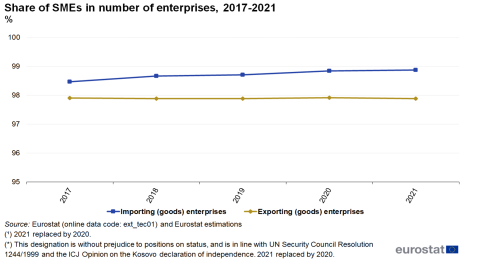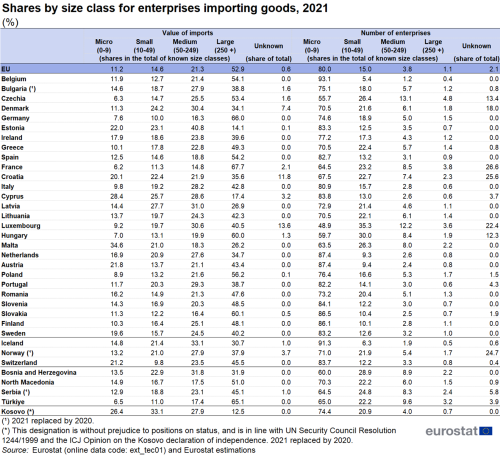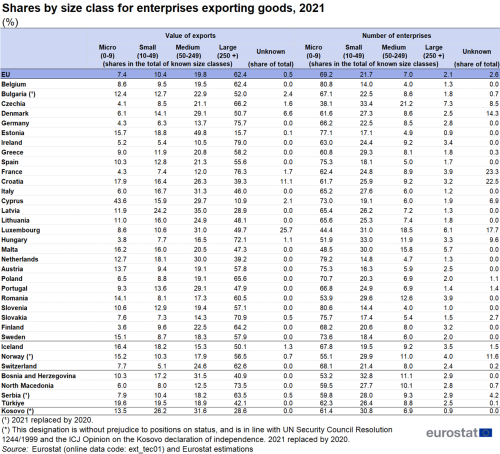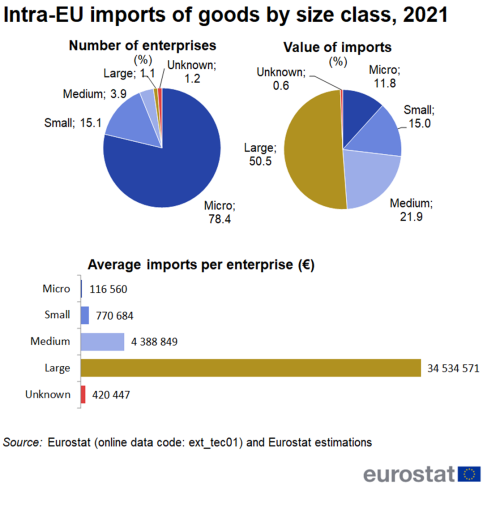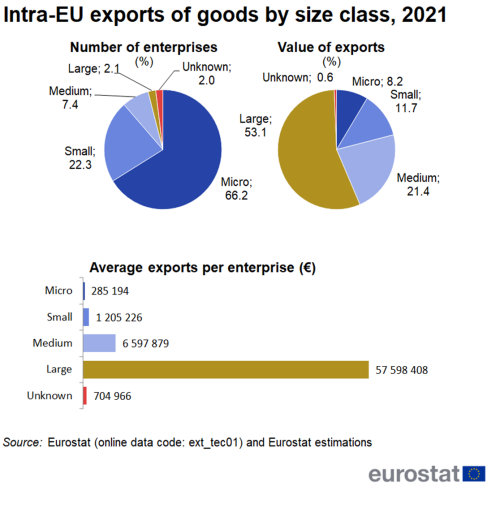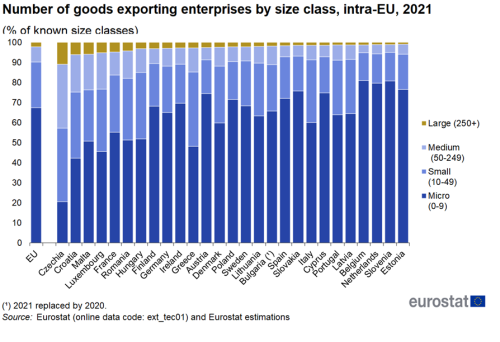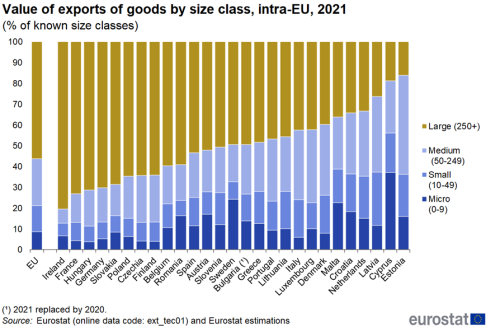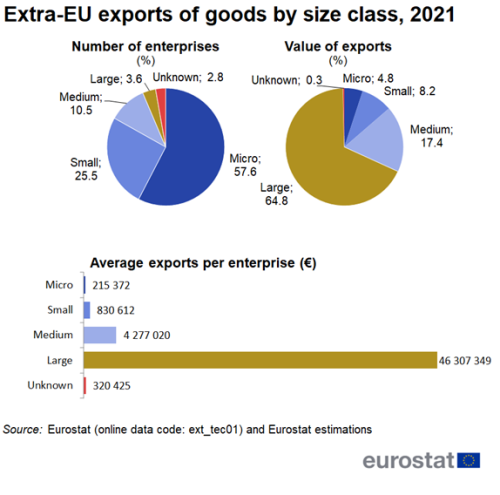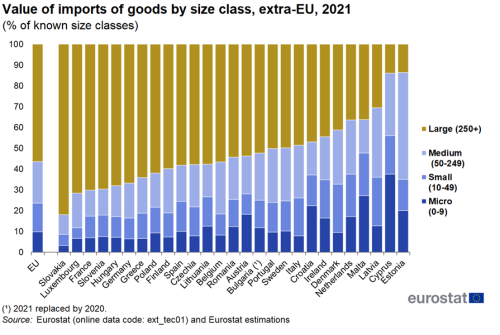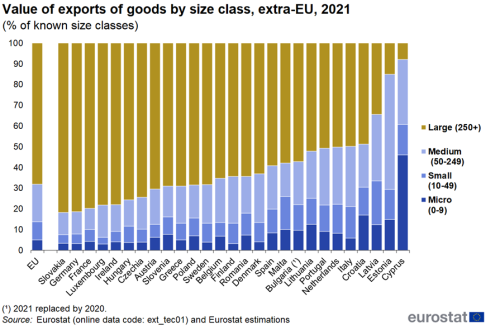International trade in goods by enterprise size
Data from October 2023.
Planned update: October 2024.
Highlights
Share of SMEs in number of enterprises, 2017-2021
This article takes a look at recent European Union (EU) international trade in goods statistics from a very specific angle: the characteristics of the enterprises actively engaged in importing and exporting.
International trade in goods statistics play a vital role in the assessment of every economy. Combining them with additional information from other sources, particularly business statistics, significantly enriches them, providing a closer picture of traders and their characteristics such as size, sector of economic activity or level of concentration. This allows for a deeper analysis of the impact of trade on employment, production and value added which are essential in a globalised world where economies are increasingly interconnected. This first article in a series of articles on trade by enterprise characteristics focusses on trade by size class (in number of persons employed) of the enterprises involved in international trade in goods.
This article is part of an online publication providing recent statistics on international trade in goods, covering information on the EU's main partners, main products traded, specific characteristics of trade as well as background information.
Full article
Overview
The main findings presented in this section focus on trade in goods by employment size class in 2021. In trade by enterprise characteristics, four employment size classes are distinguished:
- Micro: enterprises with less than 10 persons employed
- Small: enterprises with 10 to 49 persons employed
- Medium: enterprises with 50 to 249 persons employed
- Large: enterprises with more than 250 persons employed
Together the first three size classes are grouped as small and medium-sized enterprises (SMEs).
Before proceeding it is necessary to note that due to differences in the coverage of trade statistics and business registers it is not always possible to match the trading enterprises with enterprises in the business registers. Consequently, there remain a number of trading enterprises for which no size class is available. Analysis of trade values and number of enterprises suggests that micro and small enterprises are overrepresented in this unknown category.
Figure 1 shows the share of SMEs (consisting of the three size classes micro, small and medium) in total trade (intra-EU + extra-EU). Both for importing and exporting enterprises this value remained almost unchanged between 2017 and 2021. In 2021, the share for importing enterprises (98.9 %) was a little higher than that of exporting enterprises (97.9 %).
Tables 1 and 2 show that, in 2021, the vast majority of importers and exporters of goods were SMEs and within the group of SMEs the majority were micro enterprises, followed by small and then by medium-sized enterprises. Large enterprises were a small minority of the number of enterprises, but in many EU Member States accounted for the largest share in trade value among the four enterprise size classes.
The shares for the number of importing enterprises and value of imports by enterprise size class are shown in Table 1. Shares for the number of small and medium-sized enterprises did not vary much across countries. In the share for the micro enterprises, there was more variation. It was lowest in Czechia (56 %), and Luxembourg (49 %) but considerably higher in Belgium (93 %). The share for the number of large enterprises was above 4 % in Czechia but below that in all other EU Member States. There was more variation in the share of import values of the large enterprises which was lowest in Estonia (14 %) and Cyprus (17 %) and highest in Slovakia (60 %), Germany (66 %) and France (68 %).
Figure 2 underlines that the share in number of SMEs varies little among EU Member States while there is more variation in the share for their value of imports which was highest in Cyprus (83 %) and Estonia (86 %) and lowest in Germany (34 %) and France (32 %). For the EU as a whole it was 47 %.
Table 2 shows the shares for the number of exporting enterprises and the value of exports by enterprise size class. Shares for the number of small and medium-sized enterprises did not vary much across countries. In the share for the micro enterprises, there was more variation. It was lowest in Czechia (38 %), and Luxembourg (44 %) but considerably higher in Belgium and Slovenia (both 81 %). The share for the number of large enterprises was above 4 % in Malta, Luxembourg and Czechia but below that in all other EU Member States. There was more variation in the share of export values of the large enterprises which was lowest in Estonia (16 %) and Cyprus (11 %) and highest in Ireland (79 %), Germany and France (both 76 %).
Figure 3 underlines that the share in number of exporting SMEs varies little among EU Member States while there is more variation in their share for their value of exports which was highest in Cyprus (89 %) and Estonia (84 %) and lowest in Ireland (21 %), France and Germany (both 24 %). For the EU as a whole it was 38 %.
Intra-EU trade in goods by size class
Large enterprises made up only 1.1 % of the number of enterprises in intra-EU imports in 2021 (Figure 4). However, they had 50.5 % of the value of imports. Micro enterprises, although making up 78.4 % of the number of enterprises in intra-EU imports, had a share in the value of imports of only 11.8 %. The average import value of the large enterprises was roughly 8 times that of medium-sized enterprises, 45 times that of small enterprises and 300 times that of micro enterprises.
For intra-EU exports, the contribution of large enterprises to the total value was even higher than for imports (Figure 5). They accounted for 53.1 % of the trade value, although they represented only 2.1 % of the exporting enterprises. The other three groups each had lower shares in value for exports than for imports and in the case of the micro enterprises also smaller shares in the number of enterprises. The average export value of the large enterprises was roughly 9 times that of medium-sized enterprises, 50 times that of small enterprises and 200 times that of micro enterprises. These average values per enterprise were higher for exports than for imports in all enterprise size classes.
Intra-EU trade in goods by size class at Member State level
Figures 6 to 9 show the shares by enterprise size class in the number of enterprises and trade value for intra-EU trade. For each enterprise size class, the share is calculated from the enterprises with known size classes.
The share of SMEs in the number of intra-EU importers was above 99 % in Austria, the Netherlands, Slovenia, Estonia, Slovakia, Portugal, Italy, Cyprus and Belgium and lowest in Czechia (90.3 %), France (94.6 %) and Croatia (94.7 %), see Figure 6. Czechia was the only EU Member State where the number of micro enterprises (31.0 %) was smaller than the number of small enterprises (35.4 %). Within the SMEs, there were notable differences in the shares measured in value of micro, small and medium-sized enterprises across EU Member States. The share of SMEs in the value of intra-EU imports was highest in Estonia (85.6 %), Cyprus (80.8 %) and Malta (80.4 %) and lowest in France (33.5 %) and Germany (34.4 %), see Figure 7.
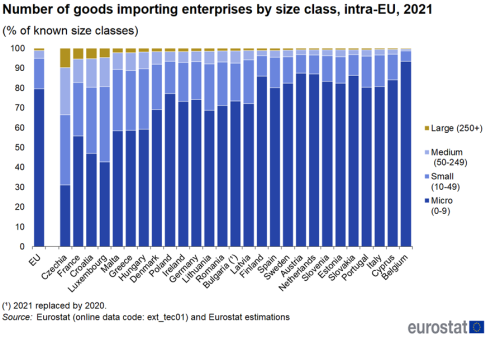
Source: Eurostat (ext_tec01)
Figure 8 shows the share of SMEs in the number of intra-EU exporters. The shares were highest in Estonia (99.1 %), Slovenia (99.0 %) and the Netherlands (98.9 %) and lowest in Czechia (89.2 %), Croatia (93.9 %) and Malta (94.1 %). The share of SMEs in the value of exports inside the EU (Figure 9) was highest in Estonia (83.9 %), Cyprus (81.2 %) and Latvia (73.7 %) and lowest in Ireland (19.5 %), France (26.9 %) and Germany (28.8 %). Comparing Figure 9 with Figure 7, for most countries, the share of large enterprises in trade value was larger in exports than in imports. This difference was highest in Ireland (80.5% in exports, 32.1 % in imports). Only in Cyprus (18.8 % in exports, 19.2 % in imports), the share of large enterprises was higher in imports than in exports in 2021.
Extra-EU trade in goods by size class
Compared with intra-EU trade (shown before in Figure 4 and 5), large enterprises in extra-EU trade had higher shares, both in number of enterprises and in trade value, in 2021. The share for the number of importers (Figure 10) was 2.8 % in extra-EU compared with 1.1 % for intra-EU. Likewise, for exporters (Figure 11) it was 3.6 % for extra-EU compared with 2.1 % for intra-EU (note that the share for the unknown category differed in intra-EU and extra-EU trade). The share in the value of extra-EU imports was 56.1 % (50,5 % for intra-EU) and in the value of extra-EU exports it was 64.8 % (53.1 % for intra-EU). However, the average value of trade per enterprise was smaller, not only for large enterprise exporters but also for medium-sized, small and micro enterprise exporters. This was also the case for large and medium-sized enterprise importers, but the opposite was true for micro and small enterprise importers.
Extra-EU trade in goods by size class at Member State level
Figures 12 to 15 show the shares by size class in the number of enterprises and trade value for extra-EU trade. For each size class the share is calculated from the enterprises with known size classes.
The share of SMEs in the number of extra-EU importers (Figure 12) was highest in Cyprus (98.8 %), Ireland and Estonia (both 98.6 %) and lowest in Czechia (94.9 %), Hungary (95.0 %) and Luxembourg (95.1 %). The share of SMEs in the value of imports from outside the EU (Figure 13) was highest in Estonia (86.4 %), Cyprus (86.0 %) and Latvia (69.5 %) and lowest in Slovakia (18.0 %), Luxembourg (28.5 %) and France (29.8 %).
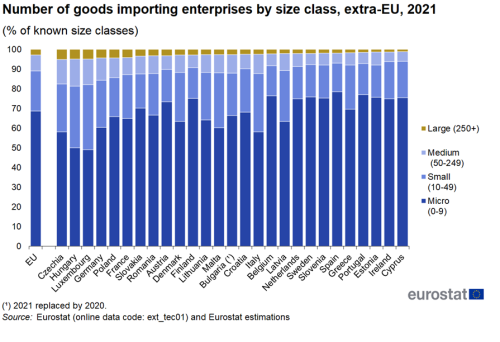
Source: Eurostat (ext_tec01)
The share of SMEs in the number of enterprises exporting outside the EU (Figure 14) was highest in Italy (98.3 %), Greece (98.0 %) and Estonia (97.7 %) and lowest in Luxembourg (89.5 %), Hungary (90.7 %) and Czechia (91.5 %). The share of SMEs in the value of exports to outside the EU (Figure 15) was highest in Cyprus (92.1 %), Estonia (84.9 %) and Latvia (65.5 %) and lowest in Slovakia (18.2 %), Germany (18.5 %) and France (20.2 %).
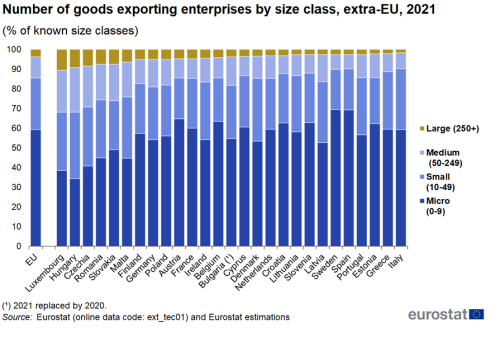
Source: Eurostat (ext_tec01)
Source data for tables and graphs
Data sources
Reporting of international trade in goods statistics by enterprise characteristics consists of a data collection independent from the monthly trade in goods statistics. This data collection has been included in the revised Intrastat (respectively Extrastat) Regulations published in 2009 that came into force for the reference year 2009 (respectively 2010) onwards.
The compilation of trade flows (exports and imports) by enterprise characteristics is based on linking micro-data on intra-EU and extra-EU trade with structural information from business registers. The trade value of each trader, by product code and partner country, is combined with the main enterprise characteristics (economic activity and number of employees) retrieved from the business registers. Only aggregated results (i.e., no micro-data) are provided to Eurostat. Confidentiality is applied in the statistics disseminated to ensure that it is not possible to identify an enterprise or a trader.
Definitions
Trade value
The value of traded goods is calculated at the national border, on a FOB basis (free on board) for exports and a CIF (cost, insurance, freight) basis for imports. Hence, only incidental expenses (freight, insurance) are included and they are incurred for:
- exports in the part of the journey located in the territory of the EU Member State where the goods are exported from;
- imports in the part of the journey located outside the territory of the EU Member State where the goods are imported to.
Number of enterprises
The number of enterprises consists of a count of the number of enterprises involved in trade during at least a part of the reference period. For intra-EU trade, VAT data are used to estimate the number of traders and the trade value of the smallest traders which are exempted from Intrastat reporting. These traders account for a limited share of the trade value but in terms of number of enterprises represent the majority.
Number of employees
The number of employees refers to the number of those persons who work for an employer and who have a contract of employment and receive compensation in the form of wages, salaries, fees, gratuities, piecework pay or remuneration in kind. A worker is considered to be a wage or salary earner of a particular unit if he/she receives a wage or salary from the unit regardless of where the work is done (in or outside the production unit).
To determine the enterprise size classes the number of employees is used. The intention is to use the situation at the end of year (including seasonally active units). As the end date approach is not harmonised, the annual average can also be used as reference calculated for a certain period.
Statistical unit
The statistical unit is the enterprise. However the enterprise concept has not yet been implemented by all the reporting countries. When the enterprise concept has not yet been implemented, reporting countries use the legal unit as an approximation of the statistical unit. Divergences in the implementation of the concept of the enterprise across EU Member States limit the comparability of the data displayed here. More information is available in the metadata file (points 3.5 and 15.1).
Legal unit and enterprise are defined as follows:
- The legal unit is a part of the legal and administrative world. Only a legal unit may enter into contracts, be an owner of a property, rights or goods (i.e. production factors). However, a legal unit does not always reflect an economic activity. This is because a legal unit is a construct of law and administration.
- The enterprise is the smallest combination of legal units that is an organisational unit producing goods or services, which benefits from a certain degree of autonomy in decision-making, especially for the allocation of its current resources. An enterprise carries out one or more activities at one or more locations. It may also be a sole legal unit.
The Business Register Regulation establishes a link between the business registers and the registers of intra- and extra-EU trade operators through a common unit of reference, namely the legal unit. The same regulation also defines the link between the legal unit and the enterprise. Via the legal unit, trade in goods data can then be linked to enterprise characteristics available in the Business Register such as the economic activity or the number of employees.
Context
International trade in goods statistics play a vital role in the assessment of every economy. Combined with additional information on characteristics of enterprises involved in international trade, such as the size and the sector of economic activity, trade data are significantly enhanced. Generally speaking, trade statistics show movements of goods between countries by goods categories. However, they do not provide explicit information on the businesses which are behind these trade flows. In a globalised world where economies are increasingly interconnected, it is more and more important to know traders and their characteristics. Answering this question requires linking trade statistics with other sources, particularly business statistics, which describe the structure and evaluation of the activities of businesses.
'International trade in goods by enterprise characteristics' is a statistical domain, which unlike traditional trade statistics, aims at describing the structure of trade by characteristics of the trading enterprises, for instance by their economic activities, their size or concentration of trade. It is based on linking trade micro-data with business register information, allowing a deeper analysis of the impact of trade on employment, production and value added.
Direct access to
- Regulation (EC) No 222/2009 of 11 March 2009 amending Regulation (EC) No 638/2004 on Community statistics relating to the trading of goods between Member States
- Regulation (EC) No 471/2009 of 6 May 2009 on Community statistics relating to international trade with non-member countries and repealing Regulation (EC) No 1172/95
- Summaries of EU Legislation: Extrastat: statistics relating to trade with non-EU countries
- Regulation (EC) No 177/2008 of the European Parliament and the Council of 20 February 2008, establishing a common framework for Statistical Business Registers is the legal basis for business registers.
- Summaries for EU Legislation: Business registers for statistical purposes
